Summary:
I have a function I want to put through curve_fit that is piecewise, but whose pieces do not have a clean analytical form. I've gotten the process to work by including a somewhat janky for loop, but it runs pretty slowly: 1-2 minutes for relatively sets of data with N=10,000. I'm hoping for advice on how to (a) use numpy broadcasting to speed up the operation (no for loop) or (b) do something totally differently that gets the same type of results, but much faster.
The function z=f(x,y; params) I'm working with is piecewise, monotonically increasing in y until it reaches the maximum value of f, at point y_0, and then saturates and becomes constant. My problem is that the break-point y_0 is not analytic, so requires some optimization. This would be relatively easy, except that I have real data in both x and y, and the break-point is a function of the fitting parameter c. All the data, x, y, and z have instrumentation noise.
Example problem: The function below has been changed to make it easier to illustrate the problem I'm trying to deal with. Yes, I realize it is analytically solvable, but my real problem is not.
f(x,y; c) =
y*(x-c*y), for y <= x/(2*c)
x**2/(4*c), for y > x/(2*c)
The break-point y_0 = x/(2*c) is found by taking the derivative of f WRT y and solving for the maximum. The maximum f_max=x**2/(4*c) is found by putting y_0 back into f. The problem is is that the break-point is dependent on both the x-value and the fitting parameter c, so I can't compute the breakpoint outside the internal loop.
Code I have reduced the number of points to ~500 points to allow the code to run in a reasonable amount of time. My real data has >10,000 points.
import numpy as np
from scipy.optimize import curve_fit,fminbound
import matplotlib.pyplot as plt
def function((x,y),c=1):
fxn_xy = lambda x,y: y*(x-c*y)
y_max = np.zeros(len(x)) #create array in which to put max values of y
fxn_max = np.zeros(len(x)) #array to put the results
'''This loop is the first part I'd like to optimize, since it requires
O(1/delta) time for each individual pass through the fitting function'''
for i,X in enumerate(x):
'''X represents specific value of x to solve for'''
fxn_y = lambda y: fxn_xy(X,y)
#reduce function to just one variable (y)
#by inputting given X value for the loop
max_y = fminbound(lambda Y: -fxn_y(Y), 0, X, full_output=True)
y_max[i] = max_y[0]
fxn_max[i] = -max_y[1]
return np.where(y<=y_max,
fxn_xy(x,y),
fxn_max
)
''' Create and plot 'real' data '''
delta = 0.01
xs = [0.5,1.,1.5,2.] #num copies of each X value
y = []
#create repeated x for each xs value. +1 used to match size of y, below
x = np.hstack([X]*(int(X//delta+1)) for X in xs)
#create sweep from 1 to the current value of x, with spacing=delta
y = np.hstack([np.arange(0, X, delta) for X in xs])
z = function((x,y),c=0.75)
#introduce random instrumentation noise to x,y,z
x += np.random.normal(0,0.005,size=len(x))
y += np.random.normal(0,0.005,size=len(y))
z += np.random.normal(0,0.05,size=len(z))
fig = plt.figure(1,(12,8))
axis1 = fig.add_subplot(121)
axis2 = fig.add_subplot(122)
axis1.scatter(y,x,s=1)
#axis1.plot(x)
#axis1.plot(z)
axis1.set_ylabel("x value")
axis1.set_xlabel("y value")
axis2.scatter(y,z, s=1)
axis2.set_xlabel("y value")
axis2.set_ylabel("z(x,y)")
'''Curve Fitting process to find optimal c'''
popt, pcov = curve_fit(function, (x,y),z,bounds=(0,2))
axis2.scatter(y, function((x,y),*popt), s=0.5, c='r')
print "c_est = {:.3g} ".format(popt[0])
The results are plotted below, with "real" x,y,z values (blue) and fitted values (red).

Notes: my intuition is figuring out how to broadcast the x variable s.t. I can use it in fminbound. But that may be naive. Thoughts?
Thanks everybody!
Edit: to clarify, the x-values are not always fixed in groups like that and could instead be swept as the y-values are held steady. Which is unfortunately why I need some way of dealing with x so many times.
